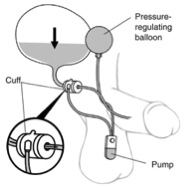An Overview of Male Urinary Incontinence
The percentage of men that suffer from male urinary incontinence is estimated to be lower than the percentage of women who suffer from it, but it is as equally serious and embarrassing for both. Urinary incontinence is the accidental leakage of urine. It is a condition that plagues men and women of all ages, but is most likely to begin occurring later in life. There are different reasons why a man may become incontinent, it could be situational or constant, but it does not have to be permanent. Plano, Frisco and Dallas, Texas urologist, Dr. Mark Allen specializes in male incontinence treatment in men of all ages.
Types of Male Urinary Incontinence
Stress incontinence– This involuntary loss of urine occurs during an event that causes stress upon the body, through abdominal pressure. Examples of this are heavy lifting, running, jumping, sneezing and coughing.
Urge incontinence– This is the involuntary loss of urine while trying to “hold it.” When a person has urge incontinence, the feeling of having to urinate is present, but the ability to effectively hold it is lost.
Overflow incontinence– This involuntary, constant loss of urine, associated with “going” frequently, usually occurs often throughout the day and in small amounts.
All of these types of incontinence can be caused by a myriad of conditions that can lead to a medical diagnosis that will explain a man’s struggle with male urinary incontinence. Among the most common are:
- Diseases which may have caused nerve damage such as diabetes, Parkinson’s Disease and Multiple Sclerosis.
- Stroke
- Spinal cord injury
- Benign prostatic hyperplasia (BPH), or an enlarged prostate
- Cancer treatment such as a prostatectomy
- Cancer treatment external beam radiation
If you are a man suffering from urinary incontinence, your first step is to see your urologist. He or she will take you through a list of diagnostic tests to determine the cause of your problem. From here, he or she will be able to decide your best option for male incontinence treatment. There is a list of treatments for urinary incontinence, and no reason why you must suffer from it for the rest of your life.
Male Incontinence Treatment Options
Most doctors will begin with the most simple and least invasive procedures, such as discussions about planning your trips to the bathroom and psychotherapy. The next step may be a discussion about medication. There are a handful of medications on the market that have been found to be helpful in more severe cases of urinary incontinence.
 If the less invasive and more conservative approach doesn’t fit with your situation, there are surgical procedures that can help. The surgery most commonly performed in the event of urinary incontinence is the placement of an artificial sphincter. As is shown in the picture, this includes the use of a cuff, a pressure-regulating balloon, and a pump (located in the scrotum), which work together to prevent urine from leaking until you are ready to do so. When ready, you manually maneuver the pump which then allows urine to be drained from the bladder.
If the less invasive and more conservative approach doesn’t fit with your situation, there are surgical procedures that can help. The surgery most commonly performed in the event of urinary incontinence is the placement of an artificial sphincter. As is shown in the picture, this includes the use of a cuff, a pressure-regulating balloon, and a pump (located in the scrotum), which work together to prevent urine from leaking until you are ready to do so. When ready, you manually maneuver the pump which then allows urine to be drained from the bladder.
Other male incontinence treatment options include:
Male Swing- In this procedure, a piece of mesh cloth is used to lift the bladder so that Urine cannot escape until the male consciously chooses to relieve himself.
Urinary Diversion– If bladder must be removed because of nerve damage, or cancer, an artificial bladder may be created, and a Urinary Diversion used. The urinary organs are replaced with others that can drain urine into a stoma, or a catheter.
You do not have to live with urinary incontinence forever. Make an appointment with your urologist today, and look forward to a future without worry.
If you live in the Plano, Frisco and Dallas, Texas area and would like more information on male urinary incontinence, or would like to discuss male incontinence treatment, please contact the urology practice of Dr. Mark Allen.
